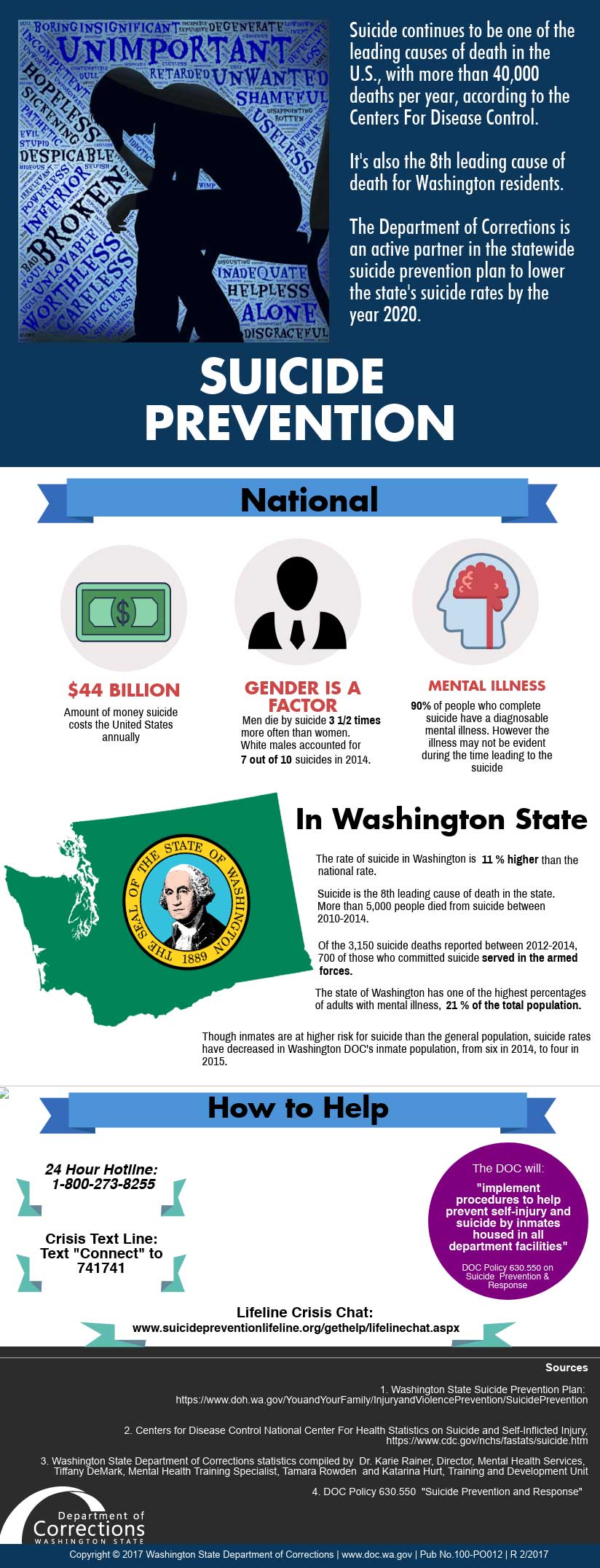INFOGRAPHIC: Suicide Prevention
100-PO012 (R 2/2017)

(Rachel Friederich , DOC Communications)
Text Version
Suicide continues to be one of the leading causes of death in the U.S., with more than 40,000 deaths per year, according to the Centers for Disease Control.
It's also the eighth leading cause of death for residents in Washington State.
The Washington State Department of Corrections is an active partner in the statewide suicide prevention plan to lower the state's suicide rates by the year 2020.
National
- 44 Billion Dollars: The amount of money suicide costs the United States annually.
- Gender is a Factor: Men die by suicide at a rate three-and-a-half times more often than women. White males accounted for seven out of ten suicides in 2014.
- Mental Illness: 90 percent of people who complete suicide have a diagnosable mental illness. However, the illness may not be evident during the time leading up to the suicide.
In Washington State
- The rate of suicide in Washington is 11 percent higher than the national rate.
- Suicide is the eighth leading cause of death. More than 5,000 people died from suicide between 2010-2014.
- Of the 3,150 deaths recorded between 2012-2014, 700 of those who committed suicide served in the armed forces.
- The state of Washington has one of the highest percentages of adults with mental illness, 21 percent of the total population.
- Though inmates are at higher risk for suicide than the general population, the number of suicides have decreased in Washington DOC's inmate population, from six in 2014 to four in 2015.
How to Help
The DOC will "implement procedures to help prevent self-injury and suicide by inmates housed in all department facilities." (DOC Policy 630.550 Suicide Prevention and Response )
)
- 24 Hour Hotline: 1-800-273-8255
- Crisis Text Line: Text "Connect" to 741741
- Lifeline Crisis Chat: www.suicidepreventionlifeline.org/gethelp/lifelinechat.aspx
Sources
- Washington State Suicide Prevention Plan
- Centers for Disease Control National Center For Health Statistics on Suicide and Self-Inflicted Injury
- Washington State Department of Corrections statistics compiled by Mental Health Services Director Dr. Karie Rainer, Mental Health Training Specialist Tiffany DeMark, and Tamara Rowden and Katarina Hurt from the Training and Development Unit.
- DOC Policy 630.550 Suicide Prevention and Response

